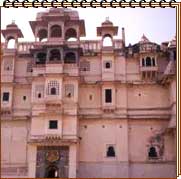 As the hub of Udaipur the City Palace stands majestically on the hill guarded by crenellated fort walls. A riot of arches, domes, turrets, crenellations and chattris crown the steep fortress. In contrast to its rugged exterior, the inside presents a delicate and feminine world of beauty with lavish use of marble, mirror work, frescoes, wall paintings, a profusion of colored glass, fluted columns, inlay work, silver doors, fountains and gardens. A series of courtyards, jharokhas, chattris, terraces, corridors, stairways, over planning pavilions and hanging gardens form an astonishing and harmonious whole. As the hub of Udaipur the City Palace stands majestically on the hill guarded by crenellated fort walls. A riot of arches, domes, turrets, crenellations and chattris crown the steep fortress. In contrast to its rugged exterior, the inside presents a delicate and feminine world of beauty with lavish use of marble, mirror work, frescoes, wall paintings, a profusion of colored glass, fluted columns, inlay work, silver doors, fountains and gardens. A series of courtyards, jharokhas, chattris, terraces, corridors, stairways, over planning pavilions and hanging gardens form an astonishing and harmonious whole.
The City Palace consists of four main and several minor palaces. Part of the complex is a Hawa Mahal. The Palace of Joy, Dilkhusha Mahal, is decorated with frescoes and wall paintings. Moti Mahal, or Palace of Pearls, Sheesh Mahal, or the palace of mirrors and glass, and Krishna Mahal are lavishly decorated with colors and paintings. Mor Chowk is known for its unique peacock motif in mosaic. Bada Mahal, the garden palace, is built on a 90 feet high natural rock formation. The Chini chitrashala houses a rich collection of Chinese porcelain and Laxmi Vilas Chowk is an art gallery, which houses a distinctive collection of Mewar paintings. The Amar Vilas, the highest point with its hanging gardens, towers and terraces, presents a majestic and panoramic view of the town and Lake Pichola.
Lately, a part of the City Palace and its zenana have been converted into a museum and opened up to the public. It presents a varied display of arms and armor, paintings and photographs, royal insignia, processional trappings and other objects, which reflect the heritage, and tradition of the Mewar and Sisodia Maharanas.
|


